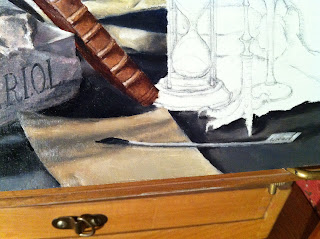Last night I finally finished my latest oil painting. It is a still-life entitled "Chamber of Reflection," and is in the traditional
momento mori genre of
vanitas still-life paintings.
Vanitas paintings can seem depressing at first glance, as they point out that all things wither away and die, but in reality the reminder that "you too will die" is a call to live a better, more positive life, enjoying all the good in the world around you, and to contribute to that good.
I am sure Jill is glad to see it finished, as now I can take down the props which have been occupying a sizable area of our bedroom for the last two months. I certainly wasn't painting for two months straight, but as I only was able to work on it here and there, the time stretched out quite a bit longer than I had originally anticipated. In fact, there were probably only about thirty hours of work time involved.
I began by laying a gesso ground on a small Masonite board - about 9" x 11". I prefer a traditional gesso made by mixing calcium carbonate with rabbit-skin glue which is painted on in many thin layers, then sanded smooth. Next I lay out my drawing on the panel. If I had planed things a bit better I would have done this in silverpoint instead of graphite, as the graphite blurred a bit when I sealed the drawing. Then I began painting each section of the painting to completion
a la prima. I used to begin with a
grisaille, but found
a la prima to generally be more satisfactory for the way I approach still-lifes and landscapes; I reserve
grisaille for figurative paintings.
At the end of each painting session I snapped a quick photo to document the process:
I tend to paint from left to right for the simple reason that I like to choke up on my brushes when I am working on details, and I rest my hand on the unpainted board. I use a mahlstick when the occasion demands, but I have never been very comfortable with it.
Here I have painted the candle-stick and a small scythe or sickle. The candle is unlit; a symbol of light, but a reminder that the light of knowledge must be obtained through effort - every man must light his own candle. The sickle is an obvious symbol of death, but also of the bounteous harvest that should be expected as the final reward of a life well lived. Grain in the field is useless until it is cut down and subjected to destructive processes like milling which alter it, making it useful and beneficial for man.
Here I have painted a rough-hewn stone, from which is emerging the polished corner of a perfected stone. Carved into the side of the stone is the acronym V.I.T.R.I.O.L. which in full reads
visita interiora terræ rectificandoque invienes occultum lapidum. This phrase invites the viewer to look inside himself for the rough stone of his character, and then take the time to polish and perfect it, revealing what has been called the 'philosopher's stone', or the secrets of personal salvation and eternal life.
Three stoppered bottles hold the elements sulphur, salt, and mercury. In ancient chemistry these were the elements of change and purification, that were obtained through the death, distillation, and perfection of all living things.
The skull is the most obvious of the
momento mori symbols. When faced with human bones, and more particularly the skull, we are uncomfortably reminded that the same bony structures are within all of us, but will only be revealed to the world after the decay of our flesh. Few things are harder to contemplate than the macabre grin of a skull which seems to laugh at all our deeds and accomplishments, and ask what use are they once we are in the grave. "Vanity, vanity, all is vanity." The skull is a reminder that we should focus our lives on the actions that outlive us, and the good that we can take with us when we leave mortality.
Juxtaposed with the skull is a book; a symbol of learning and wisdom - the only things, along with our relationships, we can take with us when we die. We should take advantage of every opportunity to augment our intelligence and expand our views.
The parchment and quill are instruments of self-reflection. When we put pen to paper we can get our thoughts out into the open, sort, organize, and analyze them, all in the search to better know ourselves.
As some philosopher once said; "Like sands through the hourglass, so are the days of our lives." That
was a famous philosopher, wasn't it? Our time on earth is measured, and nothing we can do can add a single second to our lives, so we must value each moment and try to always do good things with the time that has been given to us.
A torn loaf of bread on the right side of the painting relates to the scythe on the left. Now the death of the grain has resulted in life-giving bread; the staff of life. But bread must also be eaten in its appointed time, before it molds and loses its power to provide nutrition. All good things in life have their appropriate times and amounts.
Together with the bread is a glass of water; vital for life, in moderation, deadly in excess. The simple necessities of food and water remind us how fragile our grasp on life is.










